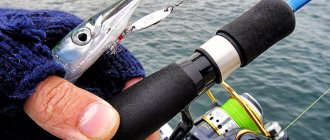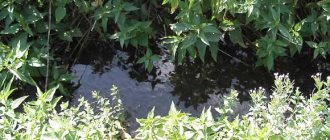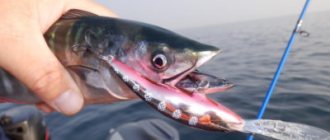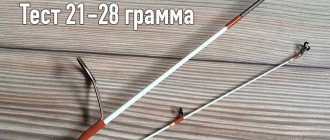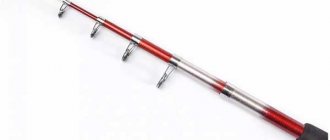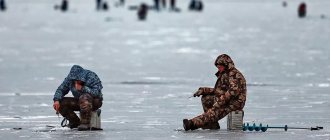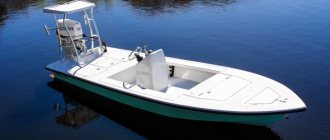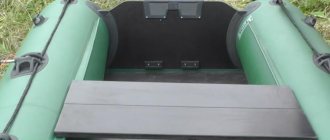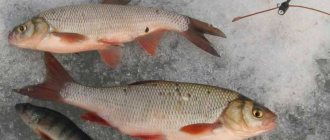This is necessary so that a larger load does not injure the delicate nod.
Today I want to show you one of the simple winter rigs and fishing rods for catching white fish in the current. Bream, roach and silver bream are well caught with this tackle.
There is nothing complicated! As they say - nothing superfluous and everything ingenious - simple.
Photo 3. Bloodworm is the main winter bait for peaceful fish.
Species diversity of fish in a winter river
Fishing in winter on the current carries a certain element of surprise. Unlike lake fishing, the river can pleasantly please you with both decent small items and trophy fish.
- Of the peaceful representatives of the ichthyofauna, several species should be noted. In winter you can count on catching trophy bream or chub. But most often the catch includes bream, silver bream and roach.
- The rivers are home to many species of predatory fish. The largest representatives are pike and pike perch. Some fishermen purposefully hunt for perch, burbot or nosebleed ruff.
Photo 1. The kings of the river are ruff!
Depending on the type of fish selected, suitable equipment is supplied.
Yawner and extractor for opening the fish's mouth and removing the hook when swallowing it deeply.
Firstly, ice is a potentially dangerous place. Do not go out on the ice if its thickness is less than 6 cm (ideally more than 10 cm). When planning winter fishing, keep in mind that in calm weather, 2.5 mm of ice freezes for every degree below zero per day. For example, at -8 degrees, 2.5 x 8 = 20 mm = 2 cm of ice will freeze per day. Bring a partner with you, you may need help.
Secondly, the risk of hypothermia. Frost is the main limiter for novice subglaciers. But we knew that it wasn’t summer outside, we could handle it!
What are the advantages and disadvantages of winter fishing?
Winter fishing is an exciting, exciting and dynamic process.
You can walk on the ice to any place, to any depth of the reservoir, and fish in the most inaccessible fishing spots.
There are types of fish that can only be caught in winter, for example, whitefish, smelt, burbot.
There is no need to throw gear far. The fisherman is in complete control of the process.
Fishing without bait - a reelless method - is possible only in winter. This is an interesting and complex, even masterly method; it is not easy to learn. But you probably won’t return home without a catch.
Minus Celsius will naturally lead to freezing of the hole and freezing of ice on the fishing line. With experience in fishing comes the skill of conquering the cold: your hands will get used to deftly moving the tackle, you will learn how to protect the hole from freezing.
Additional equipment is required: tackle and attachments, an ice auger, a fishing box, a tent with a stove and much more. But once you buy everything you need, you can easily devote time to your favorite activity.
Many fish hibernate in winter, so species diversity is somewhat less than in summer. And in the dead of winter, some fish completely lose interest in bait. There are ways to stir up lazy fish, and this only increases the excitement
Thoughtful preparation will help you choose the optimal equipment, equipment, accessories, and take into account important details.
Clothes are multi-layered. The bottom layer is natural underwear or thermal underwear. The next layer is a fleece or wool set, a woolen sweater with a high neck. The top layer should be windproof and waterproof, but at the same time wick away moisture and not restrict movement. A jacket made of membrane fabric is preferable: it will protect from wind and snow and allow sweat to evaporate. Choose a mid-thigh model, always with a deep hood.
Prefer pants with straps - overalls - this will allow you to squat and bend over and over again without freezing your lower back.
Shoes - boots made of waterproof material, for example PVC, with an inner woolen boot, with high non-slip soles, or special boots. Wool felt boots with high rubber galoshes are not bad.
A cap. Some experienced fishermen prefer earflaps coated with waterproof fabric - they cover the ears and neck. Sports woolen hats with a tight knit are also comfortable. You can put a hood on top.
Comfortable gloves with three cut fingers. You can wear mittens on top. Bring spare gloves in case you get wet.
The knife is multifunctional and scissors should always be in the drawer.
A flashlight is needed for night fishing. The LED headlamp is convenient - it “looks” in the same direction as you, and your hands are free. Take a spare set of batteries; they discharge faster in cold weather.
A depth gauge is needed to determine depth, search for holes, and study the bottom topography. A weight or a feeder on a cord can handle its function. For convenience, tie knots every meter.
A dry cloth or towel to wipe wet objects and hands and prevent them from becoming icy. Put it behind your boot, it will always be at hand.
Mothworm for live bait. It could be a foam box, a birch bark box, or even a matchbox. In the inside pocket of your jacket, your worm and maggot will be warm and will remain active and attractive to the fish.
Metal mesh with handles - for catching. A plastic bag will not work due to its fragility at sub-zero temperatures.
Metal feeder in the shape of a cube or cone.
Yawner and extractor for opening the fish's mouth and removing the hook when swallowing it deeply.
Container for live bait. There is a large selection of special containers (cannes). For the initial stage, a 6-12 liter plastic bottle with a handle is also suitable.
Interesting little things that will make fishing more comfortable: salt heating pad, heated insoles, knee pads (useful during active fishing when you have to stand near the hole).
Recipe for a special ointment. You will often have to take off your gloves and be without them for a long time. There are special winter creams that are sold in pharmacies. Many winter residents like a homemade remedy: 70% goose or pork fat and 30% petroleum jelly. The composition has a water-repellent and warming effect.
So, we have theoretically familiarized ourselves with the features of ice fishing, the bottom topography and the species composition of the fauna of the reservoir, we have chosen a place and time, it’s time to start practicing.
If you don't bite, look at your neighbors! If other fishermen are scurrying back and forth and drilling new holes, then the bite is bad for them too. If the neighbors are concentrating on jigs, it means they have found the key to the bite, and you should look for it.
Tips for fisherman: Ice drill for winter fishing with a screwdriver - Let's take it step by step
If it doesn’t bite in this hole, drill a few more nearby. Work actively with one, leave the other jigs on duty with different attachments and return to them if there is no bite every 20-30 minutes.
And in order not to freeze while searching for a bite, there are excellent tents with a stove that maintain room temperature, even at -50 degrees.
Experiment with baits and bait.
- The jig involves active fishing - a game.
- A reelless jig is a jig without natural bait.
- Float. This method is more of a wait-and-see approach: we lower hooks with bait into several holes and wait for a bite. Just keep in mind that we overload the float so that it does not freeze into the ice. If the wait is too long, we’ll feed you. More on this later.
- Zherlitsa - catching a predator with live bait.
- Winter lure - with a spoon, balancer and other artificial baits.
Choosing gear and life hacks for catching fish
Each fish has its own “character” and preferences.
Perch is a predator, active all year round. When ice freezes, the fish remain in the coastal zone, among sparse vegetation. Perch prefers water rich in oxygen. Therefore, in the dead of winter, flocks go to the depths, and by spring they approach thawed patches near the shore. To catch perch, we use a wide arsenal of gear: a jig, a float, a spoon, a balance beam and others. The bait is mostly natural. Hunting for perch in different periods of winter differs significantly, but is always interesting and productive.
Crucian carp feed sluggishly in winter, but around the clock, love warmth, and often burrow into the mud. We are looking for crucian carp in frosts down to -10 degrees not far from the shore, near the reeds. We fish with a fishing rod using a float or jig.
Roach is caught with a jig (dim and small), with a bait or a reelless bait, or with a float rig; there have been cases of catching with small spoons. Feeds around the clock, prefers shallow places. Needs bait.
Pike can be caught around the clock. Loves the borders of thickets, hunting small things from ambush. It can be found in the narrow channel in front of the bay, on migration routes. We make a chain of holes 130-150 mm in diameter at a distance of 4-5 meters from each other, and catch them with a spoon.
Burbot actively feeds at night (18-23 hours), a predator. It is caught before spawning (late December - January) and in March. We look for burbot sites and trails, for example, near shallow water areas, and catch there. We use jigs and glitter.
We look for whitefish at the edges of holes; they also love surface waters. A schooling fish, its discovery is a matter of chance. We use small spoons, act silently, whitefish are shy.
An ice drill will help us. For ice thickness up to 30 cm, a regular ice auger is ideal. Place it, press it, spin it.
At the moment when water appears in the hole, the ice auger usually comes out below the ice, although the hole has not yet been drilled. You need to lift the drill and turn it to make the hole even in width.
Drill a new hole in a new location because the ice is denser in the old, frozen hole.
The Bolognese fishing rod is not intended for long-distance casting. Rods with a length of 4 m are suitable for fishing in areas overgrown with vegetation, since the length of the equipment on this rod changes very quickly. But if you are going to fish on a wide and shallow river, then you should get a 7-meter Bolognese fishing rod on which you can install small reels.
Types of fishing rods
Fishing rods are classified according to the distinctive features of the equipment and are divided into several types.
Fly rod
This fishing rod is different in that there are no guide rings on its design . The equipment is prepared in advance at home, then it is wound on a reel, which is a device for winding and carrying fishing equipment. Its length from the top of the rod to the hook should not be much shorter than the rod itself.
People who often don’t go fishing take several rods that differ in length, as well as about 5 reels with rigs that differ in the degree of loading. This is done in order to orientate during the fishing process to a certain type of fish or other external conditions.
The equipment is attached to a shock absorber located at the top of the rod. The length of fly rods does not exceed 7 meters, but this is often too much. The design of the rod can be plug-in or telescopic. The telescopic fishing rod is unfolded according to the “joint to joint” principle.
Folding occurs in this way: when extended, the lower skirt of the upper segment of the fishing rod rests against the upper skirt of the next knee, located inside. But with a plug-in design of the fishing rod, everything happens the other way around - the upper skirt of the next segment fits into the lower skirt of the previous one.
When fishermen take several options for fishing rods, these are telescopic rods. Plug rods can be more than 9 meters in length, so the rigs can be prepared for different rod lengths.
Bolognese fishing rod
The rod is a “telescope” with guide rings . They range in length from 4 to 7 meters. "Bolonki" are designed for fishing in small reservoirs and small rivers. They are used most often during hiking and fishing without long-term feeding of fish.
The Bolognese fishing rod is not intended for long-distance casting. Rods with a length of 4 m are suitable for fishing in areas overgrown with vegetation, since the length of the equipment on this rod changes very quickly. But if you are going to fish on a wide and shallow river, then you should get a 7-meter Bolognese fishing rod on which you can install small reels.
The most significant advantage of fishing with a Bolognese fishing rod is the compactness of the rod and gear, which does not require transport or a huge backpack. In addition, such a rod is available to almost every fisherman due to its relatively inexpensive cost.
Match rods
Designed for long-distance casting and have guide rings . Fishing rods of this type consist of several plug parts and are similar in appearance to a spinning rod. Designed for long-distance casting of equipment that has a sliding float, which is important when fishing in deep places in the reservoir.
Plug rod
It looks like a fly rod, but the principle of fishing with such a fishing rod is very different. Distinctive features are noticeable during the process of landing fish. The plug fishing rod has a shock absorber made of rubber and located in the cavity of the upper knee. At one end the thin rubber is fixed with a stopper, and at the other there is a connector to which the equipment is attached.
There should be a distance of 30 to 70 cm between the top of the fishing rod and the float in order to more effectively control the location of the equipment in the fish feeding area. The distance from the float to the hook is approximately equal to the depth of the river at the fishing site.
Fishing is done not by vertically raising the rod, but by moving it horizontally towards the shore. To do this, a roller is used along which the fishing rod is retracted to the required distance. The roller must be soft so as not to damage the rod.
Tips for fisherman: Winter fishing with a reelless roach perch - What is the difference, pros and cons
Plug fishing rods cost a lot, so it would be useful to evaluate all their advantages and disadvantages.
These advantages and disadvantages are the main ones. In addition to all this, you need to pay attention to the peculiarities of the fishing conditions in which you will have to fish:
- If the depth is large, then a plug fishing rod is more acceptable.
- A fly rod is less suitable for fishing in strong current conditions.
Domestic fishermen use plug fishing rods in less than 50% of cases. This is due to the unsuitability of this rod to the conditions of our country.
The types of fishing rods presented are used in different conditions, and therefore you should make a choice by thinking in advance about all the factors that will influence the course of fishing.
How to find fish on the river? Only with a drill and checking with a fishing rod. It's good to sit on the section of calm and fast water currents. Promising places are at the bends of the river, almost along the entire width, and you never know in advance where and what you will find, even if you have studied the river very well.
Tackle
For fishing in the current I use different gear, but, obviously, they are all heavy, since it is necessary to lower the bait to the bottom and hold it there for a certain time. Light equipment will “fly up” under the influence of the jet and you won’t even dream of catching anything.
To catch white fish in the current, various bottom and float equipment are used:
- ends;
- slope;
- helicopter;
- standing fishing rod with nod;
- float rod.
- garland.
Each tackle has its own characteristics, advantages and disadvantages, and is used in different situations and for targeted hunting of different fish.
The predator's fishing is no less multifaceted. But the main directions are vertical lures and girders. In the first case, various artificial baits are used, from classic “verticals” and balancers to specific wasps and amphipods. In the second, the equipment is loaded with live bait, which is caught directly on the reservoir or brought with them already prepared.
All river gear is subject to more stringent requirements. All other things being equal, they should be stronger and more reliable than for hunting in closed reservoirs, since the flow of water affecting the equipment at the time of catching and landing fish leaves its mark.
As a rule, fishing lines with a thickness of 0.20 mm and a breaking load of over 3 kg are used on the river. The fishing rods are rigid, most are tall, and have a length of 70 cm. The reels are open type, reliable and powerful. The weight of the equipment in the current is rarely less than 20 grams.
Fishing process
How to find fish on the river? Only with a drill and checking with a fishing rod. It's good to sit on the section of calm and fast water currents. Promising places are at the bends of the river, almost along the entire width, and you never know in advance where and what you will find, even if you have studied the river very well.
So, I drill holes across the stream, if the river is small, then from bank to bank a meter and a half apart, so as not to miss. It is useless to feed in a strong current - a powerful stream will carry the bait far away, and even the fish along with it. But the river stream should not frighten, it is a helper, not an enemy. Of course, I will try to fish on the river with a light jig near the shore. I’ll throw the same bait into both the second hole and the third if the current doesn’t get stronger.
First of all, you need to know the river. You can’t choose the best place for fishing the first time, this is not discussed. You may not catch anything in a seemingly ideal place. And vice versa. Although there are, of course, some basic recommendations.
Equipment options
Together with the competent selection of the float (nod) and the weight of the equipment, the installation itself and experiments with it are the basis of tactics on the current. The following may work better or worse under different conditions:
- Blind equipment with a retractable leash,
- Sliding tackle (inline),
- Combined options.
The essence of the correct tactics for ice fishing on the current is a combination of active search and constant experimentation with equipment options until a working connection is found.
Retractable leash
On weak drafts, a winter fishing rod rig for fishing in currents with a blind sinker and a retractable leash (or several) works better. This installation method can be implemented using several methods.
- A regular diverter leash on a knot,
- Paternoster (Gardner loop),
- Asymmetrical loop,
- Denisov hinge,
- Helicopter (sliding leash).
The fisherman’s task is to experimentally select a working installation for specific conditions. Each specific equipment listed is also selected. The distance to the sinker or the length of the leash itself changes. We ensure that the hook with the bait does not dangle in the water column, but lies on the bottom and moves with the current. This can be achieved, depending on the strength of the current, by changing the distance from the sinker to the point where the outlet is attached, by varying the length, or by using additional loading of the fishing rod leads with pellets or jigs. Attaching the leash to the fishing line (in the case of conventional tying) is done with various knots - grinner, uni, bloody, fishing loop through a knot. Read more in the article about winter equipment for fishing rods. This installation works well on low draft. If the current is stronger, the equipment in the sliding version will be more sensitive.
Sliding sinker (inline)
The stronger the current, the smaller the distance from the attachment point to the sinker in a blind rig with a diverting leash needs to be made. However, the smaller this distance, the worse the sensitivity of the fishing rod. Therefore, in stronger currents it is advisable to use a sliding sinker. When biting, the fish pulls the line through it and directly acts on the nod (float). An ordinary olive with a through hole is used as a sinker; the weight is selected depending on the depth and strength of the current, from 5 to 20 grams. The fishing line is passed through the hole, and a pellet or silicone stopper is attached to it. The stopper is made sliding - you also need to constantly experiment with the length of the leash, choosing a working option. Such equipment of a winter fishing rod remains sensitive in the current with a fairly strong draft.
A small life hack - placing a foam ball 2-5 cm from the hook. This device is useful on a littered bottom, raising the hook so that it does not cling to algae. In a strong current, the ball puts additional stress on the leash, stretching it along the flow.
Combined options
Installation of winter fishing rods for fishing on currents is not limited to these options. Sometimes you need to check both the water column and the bottom at the same time, especially for roach in rivers. This is especially true when fishing for mixed-feed fish – roach, blue bream. Even bream and crucian carp sometimes prefer to take bait not from the bottom, but at some distance from it. In addition to the length of the leash, the angler needs to experiment with the fishing horizon. To do this, the diverter leash is made on stoppers in a sliding version, so that its height above the bottom can be changed. You can also add a retractable leash above the sliding sinker to the inline.
Strong current - advantages and disadvantages
The vast majority of fishing enthusiasts try to get away from places with fast currents.
Not certainly in that way. On the contrary, juveniles are unstable in the current and are unable to fight the pressure of the water. But strong fish, larger and bolder, have successfully settled in such places. The already mentioned sabrefish, as well as chub, ide, asp and, somewhat surprisingly, bream with its wide screen, which, it would seem, cannot resist the current.
An angler in the current must be prepared for a bite from a large fish. And equip yourself accordingly. It's easier on the shore. Although the current doubles the resistance of the fish when playing, it is not difficult to drag it to shallow water, and then there is the shore.
Gear in currents should be more reliable than in still water. It's not just big fish here. The current sometimes brings even larger gifts - driftwood carries water almost all year round. One day, a 70-meter barge, torn from its pier, blocked shipping for the whole day, drifting across the Urals from turn to turn until it was stopped and towed to its place.
An angler in the current must be prepared for a bite from a large fish
You can make two holes, lower the fishing rods into them and wait 20 minutes. If you don’t catch fish, you need to move to another place and make two new holes. For successful fishing, you should know the habitats of bream on the bottom.
We fish from the ice in the current. Fishing technique
FISHING TECHNIQUE
By such a loud name I will understand four main options for action:
First . It is the closest to traditional jig fishing in still water. A relatively heavy jig, overcoming the current, sinks to the bottom. Then she is given a completely standard game. Due to water pressure, vibrations are unlikely to be high-frequency and low-amplitude. Usually it's the other way around. And it doesn’t make much sense to achieve filigree wiring. It is not news that in the current the fish is much more decisive and, if it has a positive attitude, decides to attack immediately. This method is good in areas with relatively weak currents. The main disadvantage: the need to use a heavy jig, which is not always perceived positively by the fish. It is problematic to deliver light bait to the bottom.
Second . Medium-sized jigs are more profitable here. It will probably not be possible to say specifically how much it is in grams, because the strength of the current is different in different areas. The criterion for me is the following fact. The nod clearly signals that the jig has reached the bottom. Even if the contact is a few meters from the hole. It's not that important. Next we carry out the game on the rise. If there are no bites, we release about half a meter of fishing line until the next time it touches the bottom. The current will straighten the line. In the water it should look like some kind of step. Naturally, the vibrations of the jig will be more “blurred” than in the first option. And already on a 10-12-meter piece of fishing line the game will disappear completely, but this should not become a reason for immediately exhausting the tackle. A bite is still very likely. I had them at 20-25 meters. The longer the line release, the more effective the next version of my classification will be.
Third . Here, a bite is most likely at the falling stage rather than at the rising stage, which was typical for the first two cases. How to be in this case? Just hand over the fishing line in meter-long pieces, and after the jig reaches the bottom (perhaps, with a long release, the nod will stop signaling that it has touched the ground), make a sharp swing, akin to a sweeping hook. Surely, now the jig is “vigorously” flying above the bottom, and then smoothly descending to it. It is precisely this moment that we must control as much as possible, smoothly lowering the fishing rod to the hole following the jig carried away by the current. I make the speed of this release approximately 4-6 cm/s. In this case, all attention should be focused on the curved nod. The bite usually looks like it jumps up. In my opinion, two such strokes are enough to move on to the next wiring cycle, releasing the next meter-long piece of fishing line. When you think that your jig is already very far from the hole, you can carry out the wiring in the reverse order, reeling in the fishing line.
Fourth . It is logical to assume that there must be another compromise option. You're right. At a particularly promising location, you can combine the second and third options. It won’t take much time, but the results can be significant. In the same place where there was a bite or at least a suspicion of it, it is not a sin to additionally play with a jig, as described in point one.
I will give two more rather original methods of fishing in the current. I haven’t used them in practice, so I won’t give any advice. I learned about them from two avid and reliable fishermen, whose opinions I completely trust.
The first method is to float a heavy olive load (weight 20-25 grams) downstream. Naturally, the olive slides along the fishing line, to the end of which the leash is attached. I think that such tackle is justified in particularly strong currents, where any jig, even a heavy one, cannot be lowered to the bottom. It is simply and succinctly called “rolling”.
The second option, which I have not tested, is very similar to a spinning retractable leash. This method refers to more targeted fishing. A sinker is attached to the end of the fishing line, which is naturally lowered to the bottom. A little above it there is a leash with a nozzle, which, due to the pressure of the flow, will oscillate on the elongated line. In my opinion, you shouldn’t make a leash longer than a meter, otherwise the bait will leave the bottom layer.
IF YOU'RE LAZY "NODD"
Well, of course, almost every angler comes to a point when holding a fishing rod in his hands and playing with a jig gets boring. It is strictly forbidden for jig athletes to let go of the fishing rod during competitions. In our case, there is no shame in drinking tea in the frosty air and eating a couple of sandwiches or just warming your hands, while remaining in the center of fishing events. What I mean? Place several “standing” fishing rods and watch them while sitting on a box.
Stationary fishing turns out to be very effective; you can fish this way purposefully. However, it’s unlikely that you’ll be able to enjoy watching the floats here. Under the influence of the current they will certainly be dragged under the ice. Of course, you can put a large float or fix a small one on a stretched fishing line, but this will be of little use. A voluminous piece of polystyrene will transmit only the most “evil” bites and will constantly freeze. A small float that “dangles” on a stretched fishing line will only reduce the sensitivity of the gear. It certainly won’t compensate for part of the weight of the sinker by rising, as is customary in bream fishing. And there are almost no ascents - there is a confident dive of the float, if you still decide to put it on. In short, I vote for a nod - relatively hard, long and clearly visible.
This has nothing to do with greed, but I, for example, like to fish with several standing rods at the same time. Why? We still don't feed. Our focus is on fish that look for food on their own. At the same time, it can stick to certain parking spots, or it can move. You definitely shouldn’t place fishing rods at a distance closer than one meter - under the variable current, the equipment can easily get tangled. A close position is justified only when the fish is found, but does not bite often and is capricious. In other cases, I sometimes make the distance between holes up to 10 meters. This way you can quickly determine the concentration of fish.
One more point regarding searching for fish using stationary fishing rods. If there are no bites, nothing prevents us from taking and releasing two meters of fishing line, thereby changing the location of the bait. If the weight of the sinker is correctly selected, the bait will be at the bottom, moreover, also oscillating. This tactic can be compared to the active movement of vents. I usually can’t stand it for longer than 3-5 minutes without a bite - I move the tackle to another hole or change the length of the fishing line. Some people are ready to wait for hours for a bronze bream to come to the cherished edge, where this patient angler’s bait is located.
So, on one of the fishing trips, which began with a complete lack of bite on the jig, I decided to put several “standing” fishing rods. Having conditionally “blocked” the entire width of the river with them (about 40 meters), I sat down on a box to rest for a while. Before I could take my first breath, the nod closest to me confidently bent and plunged into the water. Jumping out of the box like lightning, he caught both the fishing rod and the beautiful roach. A few minutes later, another tackle worked - a heavy roach, confidently swallowing the worm, was stopped in time in its attempt to drag the fishing rod away. After that, I had to put a stick across the hole so as not to be left without gear ahead of schedule. I caught a few more fish, and then the bite died down.
I changed the length of the fishing line, moved to other holes, but there were no roaches. About twenty minutes later, when I looked at my “mini-battery” again, I didn’t see one of the three fishing rods. Fortunately, she did not float away forever, getting stuck in the hole. I'm hooking. The solid weight of the opponent, taking into account the strength of the current, made the fishing line ring dangerously. I trust the clutch on a spinning reel more than my frozen fingers (I got them wet while taking the fishing rod out of the hole). But so far only fingers are available. While I was fishing, I noticed how the neighboring tackle ended up in the water in the same way. Well, I think my opponent overtook me during his rapid bursts. In general, soon I saw the white sides of a bream a little over a kilogram. Seizing the moment, he led it into the hole and pulled it out onto the ice.
I changed the bait, cleared the line of mucus and put the bait back into the water. And only then he approached the fishing rod that was in the hole. Without much hope, I grabbed the wet handle with completely frozen hands and felt a familiar heaviness. Everything was similar to the previous fishing, with the only difference that a decent bream near the surface, looking into my eyes, freed itself from the hook. He left. The neighboring fishing rod, according to tradition, was already in the water, held on by a safety stick. This time I was still late. There was only mucus left on the line near the hook.
A little humor:
Obviously, a school of bream was passing by me, and it had an excellent appetite, and I would have caught it further, but by this time I could no longer put either a bloodworm or a worm on the hook. My hands simply wouldn’t obey. While playing, the adrenaline still somehow warmed my fingers and hands. Now one of them was blue and the other was red. I didn’t even know which one I should have started warming up with. I stopped feeling both of them.
It took me about twenty minutes to get myself in order, but by that time there was no longer a trace of the school of bream left. Only around the next bend in the river was it possible to catch a good perch and redeem myself for my morning failure in jig fishing.
And one last note regarding the stationary fishing option.
In case of very strong currents, you can use a flat sliding weight. A soft lead plate is preferable. It is easy to attach it to a fishing line without any improvised means, without cutting off the hook. This simple method allows the bait to remain at the bottom in a given place all the time. Based on my practice, the use of a heavy sliding sinker still affects the bite, and, as usual, in a negative way. However, there are situations when there is simply no other way to keep the bait near the bottom. Share on social networks:
Baits and groundbait on the current
In order to attract fish to the fishing spot, you need to pour tasty and aromatic bait into the water. You can prepare this type of complementary food yourself or buy it in specialized stores for fishermen.
When preparing bait, you should take into account that the breadcrumbs will easily be washed away by the current and carried to the fish. Also, to create a feeding path, heavy components are added to the bait.
Worms and maggots are often used for bait; their movements in the water will attract fish. Often, special feeders are used to place bait in the water. They come in a cone shape and are the most effective plant-based baits.
There is no need to use boiled porridge in the form of pearl barley or millet, since when they fall to the bottom they rot and scare away fish. The main components for bait: sunflower cake, it should have a fresh and pleasant smell.
Breadcrumbs for bait: if the bottom of the reservoir is dark, use black bread crackers; if there is sand and clay at the bottom, you need white bread crackers. If a bream notices a contrasting feeding, it will not eat it.
Fragrances for bait should be made from natural plant components, such as oils and plant seeds.
A leash is attached to the mounting, the length of which depends on the strength of the river flow and a load sufficient to hold the equipment at the fishing point. Instead of a sinker, a large jig can be used under a worm or sprat, but who knows? Alternatively, a small feeder can be used. In this case, such equipment is sometimes called a winter feeder.
Fishing rod
For fishing on river currents, tackle is used, which is built on the basis of an ordinary winter fishing rod with a reel, legs and handle. It is advisable to weight the latter with lead or other metal. This will prevent it from tipping into the hole. Any nod is used, but if possible with a bright spot for visibility from some distance.
A fishing line approximately 0.15-0.18 millimeters thick is wound onto a reel, and a loop rig is knitted at the end of it. This could be one of the summer feeder montages you are familiar with:
- paternoster;
- Gardner loop;
- helicopter;
- inline.
A leash is attached to the mounting, the length of which depends on the strength of the river flow and a load sufficient to hold the equipment at the fishing point. Instead of a sinker, a large jig can be used under a worm or sprat, but who knows? Alternatively, a small feeder can be used. In this case, such equipment is sometimes called a winter feeder.
After the fish bites, you must make a hook, and it should be done carefully, just like when you fish out an ide. Knowing that fish are less active on the hook in winter, there is no need to relax. After hooking, yazzies can make quite strong maneuvers and jerks, for which you need to be prepared. But the fish does not resist for a long time, as it gets tired, which the fisherman must quickly take advantage of and pull the trophy onto the ice.
Yazi can be active at different times of the year, so winter is not a hindrance for him. The main thing is to know when you can catch it, where and with what. We'll tell you how you can catch ides in rivers in winter.
Tips for fisherman: Which balancers are better for perch in winter - What is the difference, pros and cons
The most favorable time for fishing ides in winter is considered to be the beginning of winter, according to the first ice, and the end of the winter season, according to the last ice. Fishing is also good during thaws. But in severe frosts, ide, on the contrary, is not caught because it lies on the bottom. But, with the onset of a thaw, fish quite often come out to shallow sections of rivers. Usually it stands at depths of 5-2 meters, near riffles, trees or lowlands fallen into the water. From such places she periodically comes out to look for food near the river currents.
It is best to use bait at the end or beginning of winter. At this time, it can bring good results. It is easy to prepare, for which bloodworms and egg whites are added to the base of plant ingredients. The tactics for using such bait are simple. Having caught a random ide, a little bait is thrown into the hole. After some time, a flock of his relatives should run to this place.
After the fish bites, you must make a hook, and it should be done carefully, just like when you fish out an ide. Knowing that fish are less active on the hook in winter, there is no need to relax. After hooking, yazzies can make quite strong maneuvers and jerks, for which you need to be prepared. But the fish does not resist for a long time, as it gets tired, which the fisherman must quickly take advantage of and pull the trophy onto the ice.
Ise are often caught together with other fish that are nearby. This can be either roach or perch, and you can also focus on the bite of dace, which, together with ide, lead a similar lifestyle in winter. Happy ide fishing!
Any fishing rod will do, even the cheapest one, telescopic up to 80 cm long. It is better to secure the standard guide rings with super glue and braid. It is better to choose a handle made of EVA, it is soft and warm. And when carrying gear, you can hook a hook into it. In winter, it is better to use an inertial, simple plastic reel. It is not afraid of frost and wind, or impacts on ice. And it performs the function of simply unwinding the fishing line well. To hold it firmly on the rod, we wrap the reel to the handle, for example with electrical tape.
Fishing rods for fishing in the current
To make winter fishing on the river productive, you need to properly assemble your fishing rod. Despite the simplicity and primitiveness of some models, there are certain nuances in the equipment.
- Fishermen actively use jig rods. You can catch any peaceful fish, only the equipment of the winter fishing rod for fishing in the current is special. A fishing rod with a nod can be used either purchased or homemade. It is usually equipped with a reel or reel. The fishing line is selected taking into account the size of the fish, the strength of the current and the depth. Typically, the range of monofilament lines is in the range of 0.1-0.2 mm. To choose a jig, you should remember a simple rule.
It is important! The stronger the current and the deeper the river, the heavier and more compact the jig should be. Tungsten baits are optimal.
- One of the types of bottom gear for fishing on a river in winter is a pull-up or pull-up. It has proven itself to be excellent when catching bream in the dead of winter. Assembling the fishing rod begins by installing it on the rod with the reel guides. About 50-70 m of 0.20-0.25 mm fishing line is wound onto the drum. A sliding sinker weighing 10-20 g is installed on the fishing line and secured with a silicone stopper. A carabiner is attached to the end of the fishing line, which is needed to quickly attach the leash. It is made from monofilament 0.14-0.16 mm long, 1.0-1.3 m. A small pellet (1-2 g) is mounted on a leash 20 cm from the carabiner. Before tying hook No. 12-14, a bright bead is attached to the leading line. The shank of the hook is decorated with red cambric.
Photo 2. The fishing rod is equipped with a bright nod, noticeable in the snow.
Attention! A jig can be used instead of a hook. In this case, the pellet is not placed on a leash.
- Catching a predator is still relevant with tackle for vertical trolling. This winter fishing rod is made with your own hands for fishing in the current; it is not very different from similar gear for standing reservoirs, only the mass of bait must correspond to the strength of the current.
- Zherlitsa are also actively used on rivers in winter; there is some difference from the same fishing rods for lakes only in the equipment.
- The winter feeder for ice fishing looks much simpler than the summer version. The rod is selected with a whip 20-25 cm long. It must be equipped with legs and a bright nod. A 0.20-0.22 mm monofilament is wound onto the reel, a small feeder and a leash made of 0.12-0.14 mm fishing line are installed on the base. The size of the hook depends on the bait and the size of the fish; models No. 10-14 are quite suitable.
